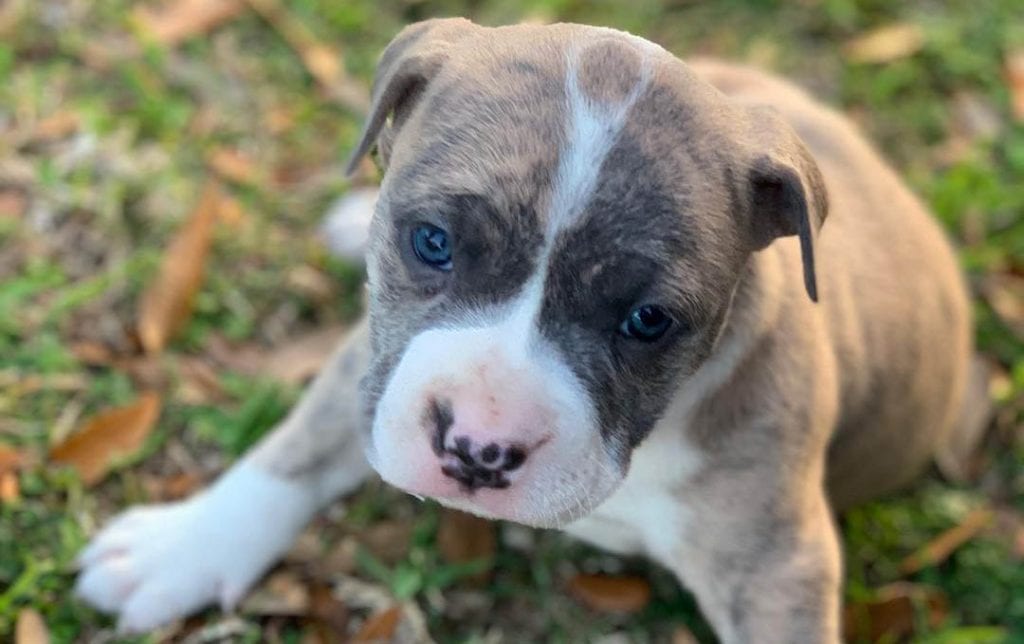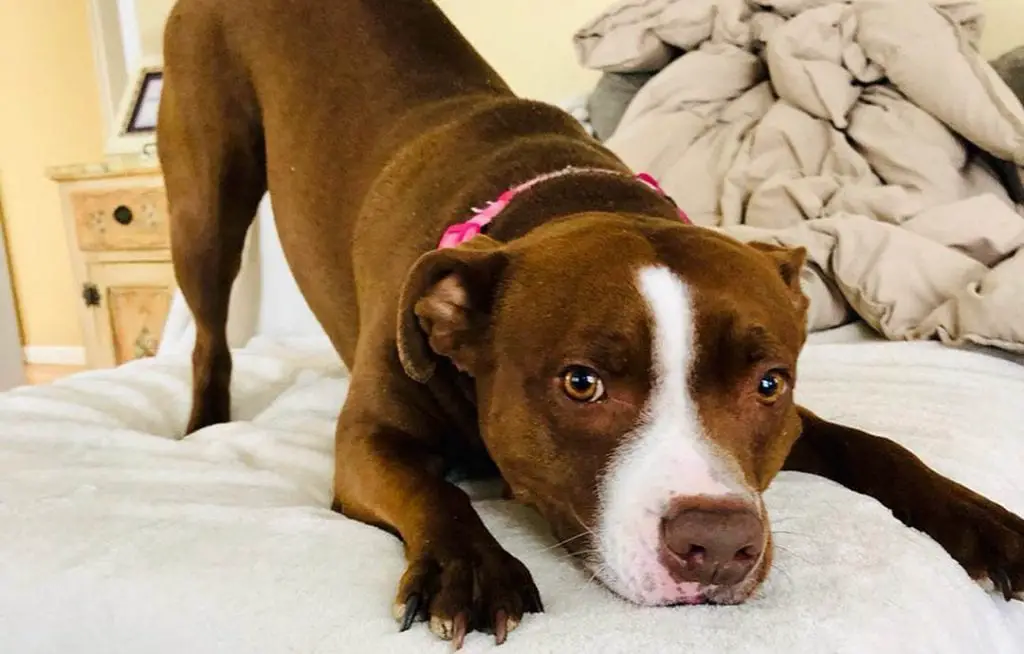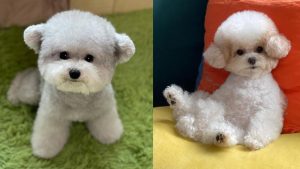Pocket Pitbull is a small pitbull that comes from the crossbreed between a Patterdale Terrier and American Pitbull Terrier. It has been popular since this breed was developed.
It is suitable for pet owners who love pit bulls but only want a smaller size. These dogs are sometimes called mini pit bulls, mini pit bulls, pocket pit, pocket bully, Patterdale, and pitbull Patterdale mix.

Facts About Pocket Pitbull
- Pocket Pitbull is a cross breed of two active purebreds. Its parent American Pitbull Terrier is commonly used as a hunting dog due to its athleticism and strength.
- On the other hand, the Patterdale Terrier is excellent for hunting animals and other species that dwell on the ground. If combined, you’ll come up with a pocket pitbull that is a great companion most of the time.
- Unlike other dog breeds, a pocket pitbull has low maintenance. Brushing its coat weekly is enough to groom it properly. It also has strong teeth, so you only need to brush it at least twice a week.
- When you heard about pocket pitbull, you may think that it is as small as a pocket. But, it’s completely different from its name. It got its name because this dog breed is smaller compared to its parent dogs.
- It is a robust and muscular dog, known for its loyalty and friendliness. Mini pitbull is also easy to train and can quickly socialize when you teach it at an early age. It is also worth noting that this pet is a great exercise buddy.
- A pocket pitbull usually lives 11 to 13 years. Within this period, it may encounter some health problems that can affect its body systems
- Take note that the mini pit bulls are highly prone to health problems if their parents are diagnosed with the following diseases or genetic disorder.
- It is essential to be aware of each of the possible health conditions so that you can bring the pet to the veterinarian as soon as the issue exists.
- Some symptoms can tell you whether your dog is doing well or not. In that way, you can immediately do the necessary things to bring back the health of the pocket pitbull.
- Knowing the physical condition, including the weight of the parent breeds can also be a great way to determine the health of its pitbull puppies.
- Check whether the parent pit bulls are overweight or have injuries. The hybrid puppies can acquire these conditions if they are not prevented as early as possible.
What health problems are Pocket Pitbulls prone to?
Heart Problems
This dangerous health condition affects the heart of the pocket pitbull. This body organ will have difficulty pumping blood and oxygen to transport it throughout the dog’s body. It may result in severe problems such as mitral valve disease, subaortic and pulmonic stenosis, and septal disease.
Congenital heart disease occurs in pocket pit bulls when their heart can no longer pump a certain amount of blood going to the brain and the entire body system.
Cause: Keep in mind that pit bulls may be born with heart disease. Sometimes, this health issue is also developed over the years. Therefore, there are instances that this problem can’t be prevented, and may even lead to death. Sometimes, aging can also trigger the heart disease to occur on mini pit bulls.
Another cause of heart disease is heartworms infection, or also called dirofilariasis. This fatal condition comes from Dirofilariaimmitis, a blood-borne parasite that resides in the heart and large blood vessels.
In some cases, it can also be found in the circulatory system and can cause complications. These elements live up to five years, but some dogs with a weak body system won’t even reach this period until they die.
Prevention and treatment: A heart disease can also be prevented in some cases. If you want to be a dog owner of mini pit bulls, you can ask for an Advanced Cardiac Exam certificate or Congenital Cardiac Exam from the dog breeder. It is essential to get this information before adopting a dog to make sure that the puppy is healthy when you have it.
Besides, giving your pet ivermectin can also prevent the heartworm from infecting his heart and blood vessels. If you are hesitant to do so, you may ask for a prescription from the veterinarian so that he can give you appropriate medicine that can protect your pet against the parasite.
If your pocket pit bull is already suffering from heart disease, some medical procedures may be required to correct the problem. X-Ray analysis is essential for the veterinarians to come up to an appropriate treatment that is safe for the pet. This method can help these professionals determine if there is a heavy heart murmur. If so, a heart operation is usually advised.

Pocket Pitbull Skin problems
Skin problems do not only occur on pocket pit bulls. It may even affect other breeds of dogs. However, there are skin diseases that mainly affect both pit bulls and their puppy breeds.
Aside from the parasites that can ruin your pet’s dermatitis, yeast and bacteria can also reside in its skin folds. This condition is easy to neglect most especially that these elements can hide.
You will only realize that your dog has the problem once you noticed that its hair is falling, leaving traces of reddish and scaly lesions. You can also observe the pet feels uneasy because of the itchy feeling brought by these skin conditions.
- Eczema – a skin disease that produces an itchy feeling and dry skin. This problem occurs when a dog has allergies or hormonal issues. It can also exist when the pet is exposed to a hot climate, and its skin cannot withstand the weather condition.
- Canine Seborrhoea – a condition characterized by excessively dry or greasy skin. The canine’s dermatitis produces too many keratinous elements that cause the skin to become flaky. It usually exists at the dog’s back or feet, and during severe conditions, it may also develop inside the skin folds.
On the other hand, the sebaceous glands of the pocket pitbull may also excessively produce sebum, which is a lubricating secretion that leads to oily skin. Take note that this skin condition can be inherited from its parent breeds, and can occur when the puppies are as young as ten weeks old.
- Acute Moist Dermatitis – also called hot spots, this skin condition is characterized with red and hairless lesions in a circular shape. It gives the canine an itchy feeling. This problem exists due to allergic reactions caused by foods, anal gland problems, parasites, and flea bites.
Prevention and treatment: It is worth noting that there are some steps you could do to prevent the occurrence of these skin conditions. One of the best ways is to keep your dog clean. It is essential to take them to bath regularly to keep those parasites from residing on their skin.
Keep in mind that poor hygiene is one of the primary reasons why a skin disease can occur regardless of your pocket pitbull’s age. Microorganisms can quickly develop when your dog’s body is dirty.
If you think that the dog’s body is aggravated with bacterial infections, it is also crucial to bring it to the veterinarian to seek for appropriate medicine that can control the spread of the disease.
Read – 25 Dog Breeds Look Like Teddy Bears
Pocket Pitbull Allergies
This skin problem is also common to other dog breeds, making them feel itchy. If you noticed your dog scratching or biting, then treat these actions as an alert. Also, observe your pet if he is sneezing or shaking his head. This problem can be due to several factors such as food, parasites, and genetic adaptation. Allergies are divided into three categories:
- Atopic allergies – Pitbull breeds are often attacked by atopic allergies because they can’t withstand dusty places. They can also efficiently react to molds and polled, making them sneeze.
- Food allergies – this type of allergy comes from foods such as grains, fish, meat, and dairy products. The market nowadays has a wide variety of food products that are specially made for dogs with allergies. Most manufacturers still make sure that it contains high-quality ingredients and nutrients needed by the canine to strive. Therefore, the best way to prevent food allergies is to opt to kind of food products suitable for your pet.
- Flea allergies – just like atopic allergies, the dog will also experience severe itching, hair loss, and scratching. You will also see traces of scabs on the pet’s skin. This problem is due to flea bites or saliva. You may use topical sprays to keep these parasites away from the dog’s body.
It is also essential to clean the surroundings to eliminate those fleas away. These elements usually reside on beddings, tables, and couches.
Aside from treating the dog using topical sprays or prescribed medicine, you must also remove the cause of this problem, and that is to vacuum the areas in your home where your dog is usually playing.
Prevention and treatment: Generally, allergies can be treated by keeping the pocket pit bull away from the allergens. You can do it by keeping your home and pet house clean regularly. Once one of your pets is affected by the allergy, make sure to check other dogs, too. A veterinarian can recommend sprays or ointment to treat the part of the skin.
If the primary source of allergy is food, you can switch to other products that also contain the same nutrients but doesn’t have the ingredient that causes the pet to feel itchy.
Joint dysplasia
Joint dysplasia is a health condition that usually occurs in the pitbull’s hips or elbows. It is sometimes called hip dysplasia or elbow dysplasia, depending on which organ is affected. The incorrect development of joints characterizes it. The dog’s cartilage that connects to its femoral head has abnormal growth, causing it to deteriorate.
If the affected part is the pit bull’s hip, this health condition will cause malformity of the ball and socket joints. The dog will experience severe pain if it is not treated as early as it occurs.
The Orthopedic Foundation of America reported that of all dog breeds, the American Pitbull Terrier is one of the most affected breeds, wherein a large population of this dog breed is dysplastic.
It is, therefore, possible that a pocket pit bull can also adapt to this health condition. So, you must ensure that the parent breed of the pocket pit bull that you are going to adopt doesn’t have a history of joint dysplasia.
Cause: The first 60 days of the pocket pit bull is crucial. It is the stage where the bones and muscles are developed. However, the incorrect development of both body parts can also occur. In this case, the bones grow faster than the muscle tissues, resulting in losing hip or elbow joints. If it affects the hips, the femoral head cartilage will deteriorate.
Aside from genetics, obesity can also contribute to the development of this health condition. Take note that the higher body mass of the dog can put pressure on its joints. Improper diet can also trigger the fast growth of the bones. If so, it is crucial for you to reduce your dog’s calorie consumption and opt for more nutritious food products.
Prevention and treatment: Since genetics play a significant role in the development of joint dysplasia, there is no known method of preventing its existence. But some ways may help you reduce the symptoms and effects on your pet.
One is to gather specific certificates for you to see the health condition of the pocket pitbull that you want to adopt. Make sure that you have one of these documents: OVC Evaluation, PennHIP Evaluation, and OFA Evaluation.
Another method is to monitor the weight of your dog. We have mentioned earlier that obesity is one of the factors of this problem. You should adjust your pet’s food intake when you observed that its weight is starting to increase.
In cases where this problem becomes severe, and your dog feels the pain, a veterinarian may recommend two different types of treatment:
- Juvenile Pubic Symphysiodesis (JPS) – this treatment is only suitable when the pocket pitbull is only 16 weeks old and below.l
- Total Hip Replacement (THR) – surgical procedure which is done to replace the entire joints with a plastic component.
Pocket Pitbull Eye Problem
Pocket pit bulls are most likely to develop different eye problems just like any other breeds. The treatment depends on the diagnosis conducted by the veterinarian.
It also has various causes and knowing each of them can help you find the appropriate solution when your pet experiences it. Some of these issues are also due to genetic problems, so it is essential to make sure that the pocket pitbull you want to adapt has good parent breeds.
- Entropion – a genetic condition that causes the eyelid to invert or roll in the eye. The eyelash of the dog can scratch the eyes of the dog, which can eventually lead to further complications such as perforation or corneal ulcers when this problem is not treated as early as possible. Corneal ulcer refers to a little fissure or dark-colored scar that builds up due to a wound. You will notice the dog rubbing his eyes, and when this condition continues to persist, it may also lead to vision loss.
- Cherry eye – this condition exists when the pitbull’s third eyelid, also called the nictating membrane, becomes infected. This defect often exists before the pocket pitbull reaches the age of two. It will result in the eyes to become swollen, and can also lead to dry eye syndrome when left untreated. Take note that the third eyelid of the dog is responsible for supplying oxygen and nutrients to the eye to sustaining the proper vision.
- Dry eyes – a condition that comes from an untreated cherry eye disorder. Because the third eyelid that supports the vision malfunctions, the gland cannot produce enough tears, resulting in eye humidification.
- Glaucoma – if dry eyes cause the glands to produce fewer tears to keep the eyes wet, Glaucoma, on the other hand, is the overproduction of eye fluids. Other symptoms include cloudy cornea, redness of the eyes, and pain on this organ. It is essential to treat this condition as early as it occurs because it can cause blindness.
- Cataract – this condition is characterized by dark eyes that result in impaired vision. These clouds block the lens of the eye, and when neglected, it will turn into a grayish-blue color or sometimes, red. In most cases, the cause of this problem is genetic. Therefore, genetic testing can be done to ensure that the pocket pitbull is not susceptible to this eye problem.
Prevention and treatment: You must observe the actions of your pet to see if he is rubbing his eyes, or this organ is swollen. It is also crucial to bring the breed to the veterinarian before the problem becomes worse.
Specific ophthalmological exams will be conducted to determine the appropriate treatment that needs to be done to correct the issue. He may prescribe topical medications like lubricants, antibiotic, and artificial-tear solution.
A surgical procedure referred to as parotid duct transposition may also be done to reroute the passage of aqueous ducts to deliver fluid in the eyes and keep it wet. If the dog is not comfortable after the surgery, he may also need medical therapy.
Hypothyroidism

This condition is rarely found on middle-aged pocket pit bulls and is often associated with cancer. Hypothyroidism can lead to inflammation of the thyroid glands and can be risky to the pet’s health.
Some signs that show if the dog has this problem are excess shedding of hair, scaly skin, weakness, dull and thin coat, and weight gain.
There are also symptoms that cannot be recognized visually such as the abnormal function of muscles and nerves and dilation of the esophagus.
Causes: Commonly, hypothyroidism is caused by two different diseases:
- Idiopathic thyroid gland atrophy – occurs when the fat tissue dominates the normal thyroid tissue.
- Lymphocytic thyroiditis – occurs when the immune system of the dog recognizes the thyroid as foreign material that enters the body, thus, mistakenly attacking it.
Prevention and treatment: Although hypothyroidism can be treated, take note that there is no known cure for this condition. A veterinarian will prescribe oral drugs that your dog should take daily for a lifetime.
He will conduct a diagnosis to determine the correct dosage that is appropriate for your dog. It contains explicitly L-thyroxine and levothyroxine, which is a humanmade hormone known to treat this kind of disease on dogs.
Despite the stated diseases, do not be discouraged when you are planning to adopt a pocket pitbull. Take note that the health of this dog still varies in many factors including lifestyle, diet, exercise, and proper grooming and care.
Giving your mini pit the right kind of food is also essential for proper growth and development. It will help him improve the formation of his body organs, muscles, bones, and cells.
You can give him raw dog foods such as organ meat, kelp, turkey, pork, and vegetables. This set of meals is a great option to ensure that the ingredients keep their minerals and nutrients.
You may also bring your pet to the veterinarian regularly most especially if you have observed some unusual behavior or his coat is starting to shed excessively.
Professional help is needed for your pocket pitbull to receive proper care. The doctor may also prescribe him vitamins or supplements required for growth and development.
Exercise is another way to keep your mini pit healthy. This breed is active and robust, which means that you need to sustain its activity needs to maintain its health and performance. Since it is a great exercise buddy, you don’t have to struggle training it to succeed.
Lastly, keeping the dog cage clean is one of the effective ways to ensure that parasites won’t reside in the skin of your pet. Make sure that its surrounding is free from fleas and insects that can cause infection.
If you do all of these things, you are not taking good care of your pocket pitbull, but you are also preventing the spread of the diseases to other pets in your home.





